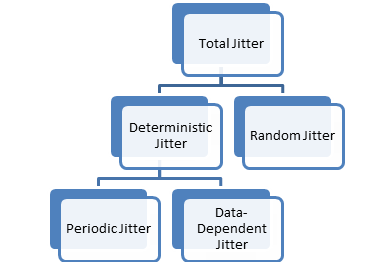What is Jitter?
Jitter, as defined by NIST, is the “short term phase variation of the significant instants of a digital signal from their ideal positions in time.” Essentially, timing jitter is the deviation of an oscillator’s edge from its ideal location. As an oscillator’s signal gets multiplied and filtered, the jitter gets multiplied and filtered as well, and a system’s timing budget can quickly disappear. Here we see just how problematic jitter can be and, as a consequence, it has become necessary for designers to possess a good understanding of timing jitter and how it will affect their system design.
Jitter can be caused by noise within the oscillator circuit or other disturbances in the system, such as power supply noise, thermal noise, vibration, and many other factors. In most discussions, the Total Jitter (TJ) of a system is split into two main categories: Deterministic Jitter and Random Jitter (DJ and RJ). The figure below shows a quick analysis of jitter including a brief introduction to the different components of DJ and RJ.

